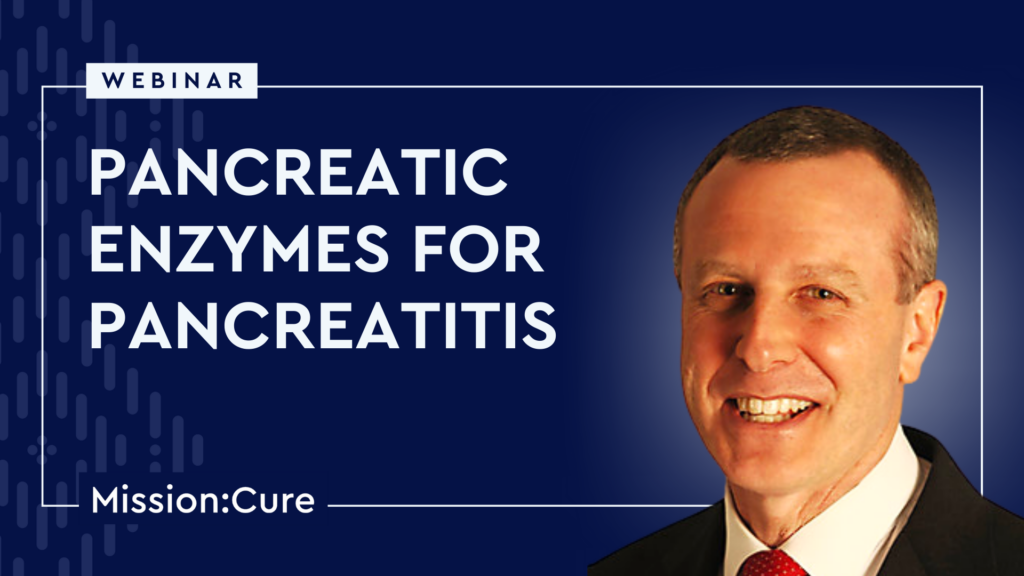Pancreatic Enzyme Replacement Therapy (PERT)

If you’ve been diagnosed with exocrine pancreatic insufficiency (EPI), talk to your doctor about pancreatic enzyme replacement therapy (PERT). PERT is used to alleviate the digestive symptoms associated with EPI, helping your body absorb the nutrients it needs.
What is pancreatic enzyme replacement therapy?
Pancreatic enzyme replacement therapy (PERT) is a treatment for those diagnosed with exocrine pancreatic insufficiency (EPI). In EPI, the pancreas doesn’t produce enough pancreatic enzymes to properly break down and absorb nutrients. Pancreatic enzyme replacement therapy involves taking medication to replace the enzymes your pancreas would normally make so you can better digest food. This medication (pancreatin/pancrelipase) contains a mixture of enzymes extracted from pig pancreas and is given in the form of capsules or tablets.
The types of enzymes in PERT include:
- Amylase. Amylase helps break down starchy foods and other carbohydrates into easily absorbable simple sugars, which your body uses for energy.
- Protease. Protease helps break down protein in food into amino acids and also protects you from bacteria and yeast found in your intestines.
- Lipase. Lipase works with bile (a fluid produced by the liver) to help break down fats in food.
The goal of pancreatic enzyme replacement therapy is to mimic the function of the pancreas during the digestive process. While PERT isn’t as effective as the enzymes your pancreas would naturally produce, it can improve carbohydrate, fat, and protein absorption in patients. This can reduce the digestive symptoms of those with EPI, such as diarrhea, abdominal pain, and malabsorption, which leads to nutritional deficiency.
Listen to Dr. Steven Freedman of Harvard Medical School explain:
- What are PERTs and what do they replace
- What the correct PERT dosage is
- How to take PERTs
Who should consider PERT?
Pancreatic enzyme replacement therapy should be considered in patients with suspected exocrine pancreatic insufficiency (EPI). Certain conditions make people more at risk of developing EPI and more likely to need PERT.
Those who may need to consider PERT include those with:
- Chronic Pancreatitis
- Pancreatic Surgery
- Older Age
- Cystic Fibrosis
- Pancreatic Cancer
- Diabetes
- Pancreatic Injury
PERT may also need to be considered in patients with acute pancreatitis, recurrent acute pancreatitis, celiac disease, inflammatory bowel disease, bariatric surgery, HIV/AIDS, and certain genetic and congenital abnormalities. These conditions may lead to EPI.
How to Take PERT
Pancreatic enzyme replacement therapy only works when taken properly. How much PERT you take is dependent on your age, weight, severity of your EPI, and the contents of your meal.
You should work with your doctor to determine the correct dose of PERT. To take PERT correctly, you should:
- Take PERT with the first bite of meals, snacks, and milk-based drinks.
- Swallow the pancreatic enzymes whole, with a cold drink.
- Do not take them with hot drinks, as the enzymes will not work properly.
- Take more enzymes if your meal is large or contains high amounts of fat.
- Spread out the enzymes throughout your meal, especially if it takes longer than 20 minutes to eat.
- Store enzymes in a cool area, away from direct heat sources, like sunlight.
Listen to Dr. Steven Freedman of Harvard Medical School explain:
- When and how to take pancreatic enzymes
- How the size of meals and the amount of fat determines PERT dose
- How to know if you’re taking the right amount of PERT
Dosing Pancreatic Enzymes
The dose of PERT varies from person to person and is dependent on the degree of exocrine pancreatic insufficiency. Doctors should determine how much pancreatic enzymes you need by your weight and age. This may change based on whether symptoms of EPI continue and disease progression.
The recommended PERT dose by age are as follows:
| Infants | 2,000 – 4,000 units per 4 oz formula or breast milk |
| Children under 4 years of age | 1,000 units per kg per meal |
| Adults and Children (4 years old or older) | 500 units per kg per meal and 250 units per kg per snack |
The recommended PERT dose by weight are as follows:
| Patient Weight | Minimum – Maximum Doses per Meal | Maximum Doses per Day |
|---|---|---|
| 110 lb. (49.9kg) | 24,950 – 124,740 lipase units | 499,000 lipase units |
| 160 lb. (72.6kg) | 36,300 – 181,500 lipase units | 726,000 lipase units |
| 200 lb. (90.7kg) | 45,350 – 226,750 lipase units | 907,000 lipase units |
FDA-Approved examples of weight-based dosing of PERT
The amount of pancreatic enzymes you take can also change based on the size of your meal and the amount of fat it contains. If you’re eating a particularly large meal or a high-fat meal you may want to increase the dose of your pancreatic enzymes.
Dosing should not exceed 2,500 lipase units per kg of body weight per meal, or 10,000 lipase units per kg of body weight per day. Pancreatologists suggest that dosing should consider exocrine pancreatic function and the amount of fat consumed. Talk to your pancreatic specialist for the dose that is right for you, which may change over time.
When to Take Pancreatic Enzymes
Pancreatic enzymes should be taken with food; specifically, with the first bite of your food. This includes meals, snacks, and milk-based drinks. Pancreatic enzymes should be spread out over your meal if it is particularly large or takes you longer than 20 minutes to eat. The goal of this is to mimic how your pancreas would normally behave to the amount of food and types of fats you are eating.
Side Effects of PERT
Pancreatic enzyme replacement therapy typically does not cause side effects; however, if the pancreatic enzymes are not absorbed properly, it can cause minimal side effects.
Side effects of PERT may include:
- Stomach pain
- Bloating, diarrhea, or gas
- Dizziness, headaches
- Gout, specifically in Cystic Fibrosis patients
It’s important to note that these symptoms may also be a result of your PERT dose being too low, rather than side effects of the medication. Talking to your doctor about increasing your PERT dose may help. More information about the side effects of your pancreatic enzymes can be found in the package insert that comes with your medication, or talk to your pharmacist to learn more.
Available Pancreatic Enzymes
There are six FDA-approved PERT medications, which are available to patients by prescription only:
Over-the-counter pancreatic enzymes are available; however, these are not FDA-regulated and may contain different amounts of lipase than what is advertised. Because PERT is only effective when taken correctly, it’s best to talk to your doctor about getting a prescription.
Frequently Asked Questions
Taking PERT whole allows the enzymes to work best. If you find this is too difficult, talk to your healthcare provider about possibly switching to a different brand with smaller capsules. If that isn’t an option, you may try opening the capsules and sprinkling them on cold, soft food. Take them right away, then take a sip of cold water to make sure you swallowed everything. Never bite or chew the capsules, as the granules can cause damage to your mouth.
Currently, there are no FDA-approved vegan pancreatic enzymes.
Drinking appropriate amounts of fluid with PERT is recommended. In EPI, the pancreas often isn’t secreting as many fluids as it normally would. This can make it difficult for the enzyme capsules to dissolve correctly. Staying properly hydrated can help your body absorb PERT better.
Unfortunately, pancreatic enzymes can be very expensive. If the cost of PERT is too much for you, there are patient assistant programs you can explore or talk to your healthcare provider about.
Some small portions of fruits and vegetables, along with some milk-free drinks, don’t need to be taken with PERT; however, this may change based on how your body reacts to specific foods and the severity of your EPI.
Key Takeaways
- Pancreatic enzyme replacement therapy (PERT) treats exocrine pancreatic insufficiency by replacing the enzymes your pancreas would normally make, helping with digestion and other symptoms of EPI
- PERT may be needed for people with chronic pancreatitis, pancreatic surgery, older age, cystic fibrosis, pancreatic cancer, and diabetes
- Taking PERT correctly involves a doctor determining the right dose, taking with the first bite of foods, and changing the amount of enzymes based on the size of the meal and how much fat is in it
- Creon, Pancreaze, Zenpep, Ultresa, Viokace, and Pertze are PERT medications available to patients by prescription only in the U.S.

